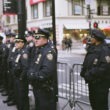The (Supreme Court) Case for Immigration ReformSheer incapability or lax enforcement of the laws barring entry into this country, coupled with the failure to establish an effective bar to the employment of undocumented aliens, has resulted in the creation of a substantial “shadow population” of illegal migrants—numbering in the millions—within our borders. This situation raises the specter of a permanent caste of undocumented resident aliens, encouraged by some to remain here as a source of cheap labor, but nevertheless denied the benefits that our society makes available to citizens and lawful residents. The existence of such an underclass presents most difficult problems for a Nation that prides itself on adherence to principles of equality under law.
—Supreme Court Justice William J. Brennan Jr., 1982
DID GOVERNOR JAN BREWER’S LEGAL STAFF miss the memo? The constitutional challenges to the anti-immigrant bill she signed into law in April have already been litigated in Texas. And everything the federal courts (including the Supreme Court) have said about Texas’s attempt to create its own immigration policy suggest that Arizona’s “Support Our Law Enforcement And Safe Neighborhoods Act” is a losing wicket.
Texas has been using racial profiling to identify and expel unwanted aliens since the 1850’s, when the cities of Seguin and Austin banned Mexicans. The state’s nativists were pushed back in 1982, when the Supreme Court reminded them that the equal protection clause of the 14th Amendment applies to citizens and non-citizens—and that Texas public schools could no longer require students to provide proof of citizenship.
The state’s oral arguments before the high court in 1981 were similar to arguments Arizona legislators used to justify a law that requires police to demand proof of citizenship or residency when they suspect someone is in the country illegally.
The federal government is “doing very little to control the problem other than deny its largesse to illegal aliens,” an assistant attorney general from Texas told the nine justices. “[W]ith the federal government doing very little, nothing at all, realistically…,” the state had to step in and deal with the illegal alien problem.
William Wayne Justice, the East Texas district judge who tried the case, had already disposed of that argument. Justice wrote that Congress has an “exclusive authority to regulate immigration.” He added that immigrants, even undocumented immigrants, are subject to the equal protection clause of the 14th Amendment.
Supreme Court Justice William Brennan wrote the opinion for the 5-4 majority that upheld Judge Wayne Justice’s ruling, observing that: “The 14th Amendment to the Constitution is not confined to the protection of citizens. It says: ‘Nor shall any state deprive any person of life, liberty, or property without due process of law; nor deny to any person within its jurisdiction the equal protection of the laws.’ These provisions are universal in their application, to all persons within the territorial jurisdiction, without regard to any differences of race, of color, or of nationality; and the protection of the laws is a pledge of the protection of equal laws.” (The italics are Brennan’s added emphasis to an 1886 Supreme Court opinion he quoted.) Brennan also reaffirmed that the right to make immigration policy belongs exclusively to the Congress.
TEXAS TWO-STEP—Recent court rulings in Texas bear directly on the Arizona law. In 2006 a Dallas suburb tried to do what the state of Arizona is now trying to do. Almost. People who appeared to be suspiciously Mexican were free to drive through Farmers Branch. But before they could rent a place to live, they would have to produce a birth certificate, passport, or green card.
After Federal District Judge Sam Lindsay overturned the Farmers Branch city ordinance in 2008, the city council put the ordinance to a public vote. It passed 4,059 to 1,944. And Lindsay overturned it again. “While recognizing the frustration of citizens and public officials regarding the lack of enforcement of federal immigration laws,” he wrote, “the court reiterates that the ‘will of the people’ in endorsing the Ordinance does not bestow the imprimatur of constitutionality on the Ordinance.”
The Supreme Court, according to Lindsay, “has repeatedly held that the power to regulate immigration is exclusively a federal power.”
Last month the Farmers Branch ordinance was put to a final rest by Federal District Judge Jane Boyle in Dallas, who issued a permanent injunction and repeated that “the authority to regulate immigration is exclusively a federal matter.”
The law could not be much clearer. Or more settled.
RAZING ARIZONA—There is at least one direct link between the anti-immigrant ordinance in Texas and the anti-immigrant law in Arizona. The city of Farmers Branch brought in Kris Kobach—who had served as chief adviser on immigration law for former U.S. Attorney General John Ashcroft—to draft the ordinance.
I don’t think that Kobach has yet offered to help Farmers Branch with the $3.5 million in taxpayer dollars spent defending the ordinance he drafted. But Kobach, who is running for secretary of state in Kansas, helped draft the Arizona law. He’s also working with Maricopa County Sheriff Joe Arpaio (who is facing a Justice Department investigation for civil rights abuses) to refine arrest procedures that will conform with the new Arizona law.
(This skin game and the architects of the devious laws that perpetuate it is a recurrent theme in American history. The 1866 Supreme Court case that Justice Brennan cited in the Texas education ruling involved a seemingly innocuous San Francisco Board of Supervisors ordinance that required all owners of laundries housed in wooden buildings to apply for permits, which were universally denied. In 1886, 90 percent of San Francisco’s laundries were owned by Chinese immigrants.)
In Arizona, Kobach worked with Republican State Senator Russell Pearce, the lead sponsor of the law. Pearce is a nativist known for his American-flag sports shirts and a politics more offensive than his sartorial excess.
Pearce is virulently anti-immigrant. He has praised a 1950’s deportation program called “Operation Wetback.”
He sent out a mass e-mail that included an attachment from a neo-Nazi group (which he claimed was inadvertently mailed, but nonetheless provides some insight into his reading habits).
And rather than cutting his ties with a Republican county official whom the Anti-Defamation League and the Southern Poverty Law Center had revealed as a neo-Nazi, Pearce appeared at a June 2006 anti-immigration rally where neo-Nazi J.T. Ready publicly praised the Republican state senator as a “statesman.”
The ADL had documented Ready’s neo-Nazi affiliation, at a March 7, 2006, legislative conference in Phoenix. Ready’s politics, however, were no secret in Arizona, where he had been filmed marching with neo-Nazi protestors.
The new law that Pearce sponsored is good (if repugnant) Republican politics in Arizona because it turns on the party’s anti-immigrant base.
Perversely, it’s good progressive politics. Kris Kobach has done for the state of Arizona what he did for a small suburb in Texas: drafted legislation that will transfer the state’s wealth into the accounts of the Mexican American Legal Defense and Education Fund and the American Civil Liberties Union, whose legal staffs are already preparing lawsuits.
The “Support Our Law Enforcement And Safe Neighborhoods Act” might as well have been called “The Full-Employment Act for Civil Rights Lawyers.” A week after the Arizona governor signed it, it had been amended once and two lawsuits had already been filed.





0 Comments